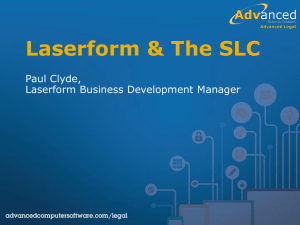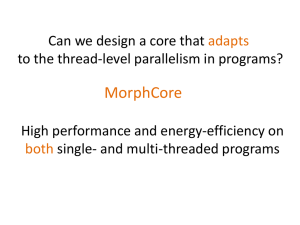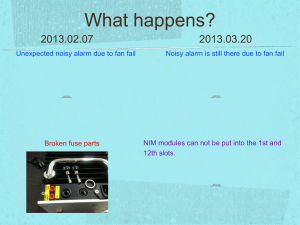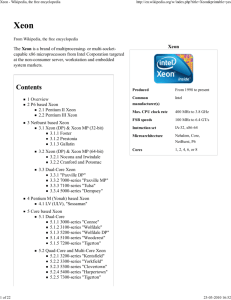Jarp_Mar12_SNB-EP-testimonial_ZH_V3
advertisement
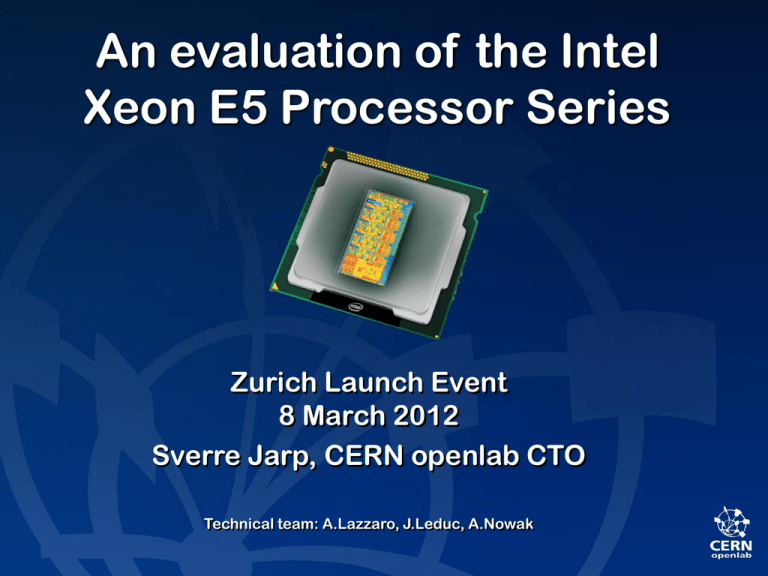
An evaluation of the Intel Xeon E5 Processor Series Zurich Launch Event 8 March 2012 Sverre Jarp, CERN openlab CTO Technical team: A.Lazzaro, J.Leduc, A.Nowak Mont Blanc (4,808m) Geneva (pop. 190’000) Lake Geneva (310m deep) Intense data pressure creates strong demand for computing Raw data: a few petabytes per second Tens of petabytes stored per year 250’000 IA computing cores A rigorous selection process enables us to find that one interesting event in 10 trillion (1013) The Worldwide LHC Computing Grid Tier-0 (CERN): data recording, reconstruction and distribution Tier-1: permanent storage, reprocessing, analysis Tier-2: Simulation, end-user analysis nearly 160 sites ~250’000 cores 173 PB of storage > 1 million jobs/day 10 Gb links The CERN openlab A unique research partnership of CERN and the industry Objective: The advancement of cutting-edge computing solutions to be used by the worldwide LHC community • Partners support manpower and equipment in dedicated competence centers • openlab delivers published research and evaluations based on partners’ solutions – in a very challenging setting • Created robust hands-on training program in various computing topics, including international computing schools; summer student programme • Past involvement: Enterasys Networks, IBM, Voltaire, Fsecure, Stonesoft, EDS; New contributor: Huawei • Just started phase IV: 2012-2014 http://cern.ch/openlab Benchmarking: A complex affair • In modern servers, at least the following elements need to be controlled: – Hardware: • • • • • • • • • Processor generation Socket count Core count CPU frequency Turbo boost SMT Cache sizes Memory size and type Power configuration – Software: • Operating System version • Compiler version and flags 8 March 2012 6 Xeon E5 in some detail • Advanced Vector eXtensions (AVX) – 256 bit registers which can hold 4 doubles/8 floats – AVX instruction set • More execution units – Two load units, for instance • Enhanced Hyper-threading and Turboboost technology • Larger on-die L3 cache • Integrated PCI Express 3.0 I/O 8 March 2012 7 Our Xeon E5 testing • System tested: – Beta-level white box; Dual-socket server. – Xeon E5-2680 @ 2.7 GHz, 8 cores, 130W TDP • 32 GB memory (1333 MHz) • C1 stepping – Code name: “Sandy Bridge EP” • Benchmarks used: – – – – HEPSPEC HEPSPEC/W MT-Geant4 MLfit 8 March 2012 8 HEPSPEC • Throughput test from SPEC 2006 – All the C++ jobs (INT as well as FP); As many copies as cores – Scientific Linux CERN (SLC) 5.7/gcc 4.1.2/64-bit mode/Turbo off/SMT on – Compared to 6-core “Westmere-EP” Xeon X5670 (@2.93 GHz) • Frequency-scaled 349 Using only the “real” cores: Speed-up per core: 1.2x Core count: 1.33x Total: 1.6x HEPSPEC 284 219 198 177 156 134 83 73 SMT gain (for both): 44 22 1.23x Sandy Bridge-EP E5-2680 Westmere-EP X5670 (frequency scaled) 0 0 4 8 12 16 20 24 32 #CPUs 8 March 2012 9 Energy efficiency • For CERN and most W-LCG sites, energy efficiency is paramount – Our centres have (more or less) a fixed amount of electric energy – Ideally, we would like to double the throughput/watt from generation to generation – This was relatively easy when core count increased geometrically: • 124 – Recently, however, it has been increasing arithmetically: • 4 (Xeon 5500) 6 (Xeon 5600) 8 (Xeon E5-2600) 8 March 2012 10 HEPSPEC/Watt • Great news: Bigger jump than foreseen in energy efficiency! – Now reaching 1 HEPSPEC/W which is 1.7x compared to Xeon X5670 • Xeon E5 options: SLC 5.7, 64-bit mode, SMT on, Turbo on • Xeon 5600 options: SLC 5.4 Xeon E5-2600 E5-2680 HEP performance per Watt Turbo-on running SLC5 E5-2680 SMT-off E5-2680 SMT-on Bigger is better! 1.039 0.925 X5670 HEP performance per Watt (extrapolated from 12GB to 24GB) X5670 SMT-off X5670 SMT-on SPEC / W 0.8 0.8 0.611 SPEC / W 0.5059 Xeon 5600 0.4 0.4 0.2 0.2 0 0 STOP PRESS: With SLC 6 (gcc 4.4.6) we further lower the power consumption by 5% 8 March 2012 11 and increase the HEPSPEC results by 3%: 1.083x in total ! MT Geant4 SLC 5.7, gcc 4.3.3, pinning of threads • Our favourite benchmark for testing weak scaling: • A threaded version of CERN’s detector simulation program – Speed-up compared to previous generation (L5640@2.26GHz): • Both with Turbo-off, SMT-on (L5640 frequency-adjusted): 1.46x Xeon E5-2600 SMT speed-up: 1.25x 8 March 2012 12 MLFit SLC 6.2, icc 12.1.0, pinning of threads • Our favourite benchmark for testing strong scaling: • A threaded/vectorised data analysis program – – – – Single core (Turbo off, using SSE): Single core, moving to AVX: All the “real” cores w/SSE: (1.33 * 1.19) All the “real” cores & AVX: (1.59 *1.12) 1.19x 1.12x 1.59x 1.78x 1.33x Xeon E5-2600 SMT speed-up: 1.29x 8 March 2012 13 Conclusion • The Intel Xeon E5 Processor Series confirms Intel’s desire to improve both absolute performance and performance per watt • CERN and W-LCG will appreciate both – In particular, the HEPSPEC/W value – Now reaching 1 HEPSPEC/W which is 1.7x compared to previous generation (Xeon X5670) • A full openlab evaluation report will be published at launch time – http://www.cern.ch/openlab – The Xeon X5670 report is available since April 2010 8 March 2012 14




